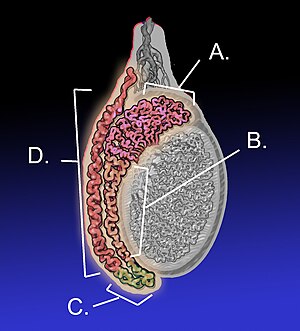Epididymitis
| Epididymitis | |
|---|---|
 |
|
| Adult human testicle with epididymis: A. Head of epididymis, B. Body of epididymis, C. Tail of epididymis, and D. Vas deferens | |
| Pronunciation |
|
| Classification and external resources | |
| Specialty | Urology, infectious disease |
| ICD-10 | N45.0 |
| ICD-9-CM | 604 |
| DiseasesDB | 4342 |
| MedlinePlus | 001279 |
| eMedicine | med/704 radio/261 emerg/166 |
| Patient UK | Epididymitis |
| MeSH | D004823 |
Epididymitis is a medical condition characterized by discomfort or pain of the epididymis, a curved structure at the back of the testicle in which sperm matures and is stored. Epididymitis is usually characterized as either acute or chronic: if acute, the onset of testicular pain is often accompanied by inflammation, redness, and warmth in the scrotum; if chronic, pain may be the only symptom. In either form, testicular pain in one or both testes can vary from mild to severe, and one or both epididymides may noticeably swell (inflame) and/ or harden (indurate). The pain is often cyclical and may last from less than an hour to several days.
Epididymitis is the most frequent cause of acute onset scrotal pain in adults. In contrast with men who have testicular torsion, the cremasteric reflex (elevation of the testicle in response to stroking the upper inner thigh) is not altered. If the diagnosis is not entirely clear from the patient's history and physical examination, a Doppler ultrasound scan can confirm increased flow of blood to the affected epididymis (whereas torsion is characterized by ischemia). If the inflammation spreads to the testicle, the condition may be reclassified as epididymo-orchitis or orchiepididymitis.
The swelling from epididymitis may stretch along the inguinal canal and may appear similar to that of a hernia, particularly an inguinal hernia. It may be distinguished from these, however, in that with the exception of an incarcerated indirect inguinal hernia, inguinal hernias generally are not painful, and the swelling they produce often disappears upon lying down. Neither is the case with epididymitis. Also, hernias are not episodic, whereas epididymitis frequently is.
The mean age of patients who present with epididymitis is 41 years. The acute form usually develops over the course of several days, with pain and swelling frequently in only one testis, which will hang low in the scrotum. There will often be a recent history of dysuria or urethral discharge. Fever is also a common symptom. In the chronic version, the patient may have painful point tenderness but may or may not have an irregular epididymis upon palpation, though palpation may reveal an indurated epididymis. A scrotal ultrasound may reveal problems with the epididymis, but such an ultrasound may also show nothing unusual. The majority of patients who present with chronic epididymitis have had symptoms for over five years.
...
Wikipedia
